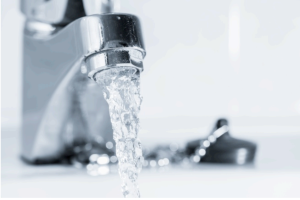So youʼve washed your hands, done the dishes, or brushed your teeth. You turn off the water and walk away, only to be bothered minutes later by the sound of dripping. Or maybe you noticed that your water bill this month was just a little higher than normal. Whatever the case, a faucet that leaks itʼs more than an annoyance; itʼs a waste of water. But when youʼve pushed the handle as far as you can and the leak wonʼt stop, how should you fix it? The good news is, for most faucets the solution is inexpensive and quick. Less than an hour and a small investment and you can restore your faucetʼs water stopping abilities!
 Before you begin, check your faucet type. While there are many kinds, most leaky fixtures are compression faucets. Compression faucets can be identified with separate hot and cold handles, and the pressure used to turn them off. These are older faucets, and you will feel the handle tighten as the water is turned off. Newer faucets often require specialty maintenance, however are less prone to leaks. If unsure, you can also check your manufacturerʼs website, as many of them have instructions for repair, or contact information to get specifics. The majority of leaky faucets however will prove to be a simple compression faucet, so letʼs look at repair methods for these.
Before you begin, check your faucet type. While there are many kinds, most leaky fixtures are compression faucets. Compression faucets can be identified with separate hot and cold handles, and the pressure used to turn them off. These are older faucets, and you will feel the handle tighten as the water is turned off. Newer faucets often require specialty maintenance, however are less prone to leaks. If unsure, you can also check your manufacturerʼs website, as many of them have instructions for repair, or contact information to get specifics. The majority of leaky faucets however will prove to be a simple compression faucet, so letʼs look at repair methods for these.
The first step in repair is to turn off the water. The control for this can usually be found
under or near the sink. Once the water is off, remove the handle that is leaking. To
remove this, first locate a decorative piece that can be easily pried off usually near the
middle of the handle. There should be a screw underneath holding the valve in place.
By removing the screw, you can detach the handle by turning counter clockwise. Next,
remove the washer, which is identifiable as a rubber ring around the base. There should
be a screw holding this in place as well.
under or near the sink. Once the water is off, remove the handle that is leaking. To
remove this, first locate a decorative piece that can be easily pried off usually near the
middle of the handle. There should be a screw underneath holding the valve in place.
By removing the screw, you can detach the handle by turning counter clockwise. Next,
remove the washer, which is identifiable as a rubber ring around the base. There should
be a screw holding this in place as well.
The leak will be caused by either a faulty valve, or faulty washer. When removing the handle above, simply replace the washer with a new one. You can find one at a local hardware or plumbing store. Itʼs crucial to make sure you have the right size! We recommend taking your handle with you when you purchase one. If replacing the washer doesnʼt fix it, it may be a faulty valve. Chances are your valve will need to be replaced as they corrode overtime. You can remove this with a valve seat wrench. Make sure you replace it with one of the exact same size.
If after replacing both you find that the leak has not been solved, there may be more serious issues behind the scenes. Or it may simply be that you made a mistake in the process. Donʼt worry, it happens. At this point call a plumber to have a look for you. We can recommend a trustworthy one! If you need a professional plumbing contractor, check out http://www.
No comments:
Post a Comment